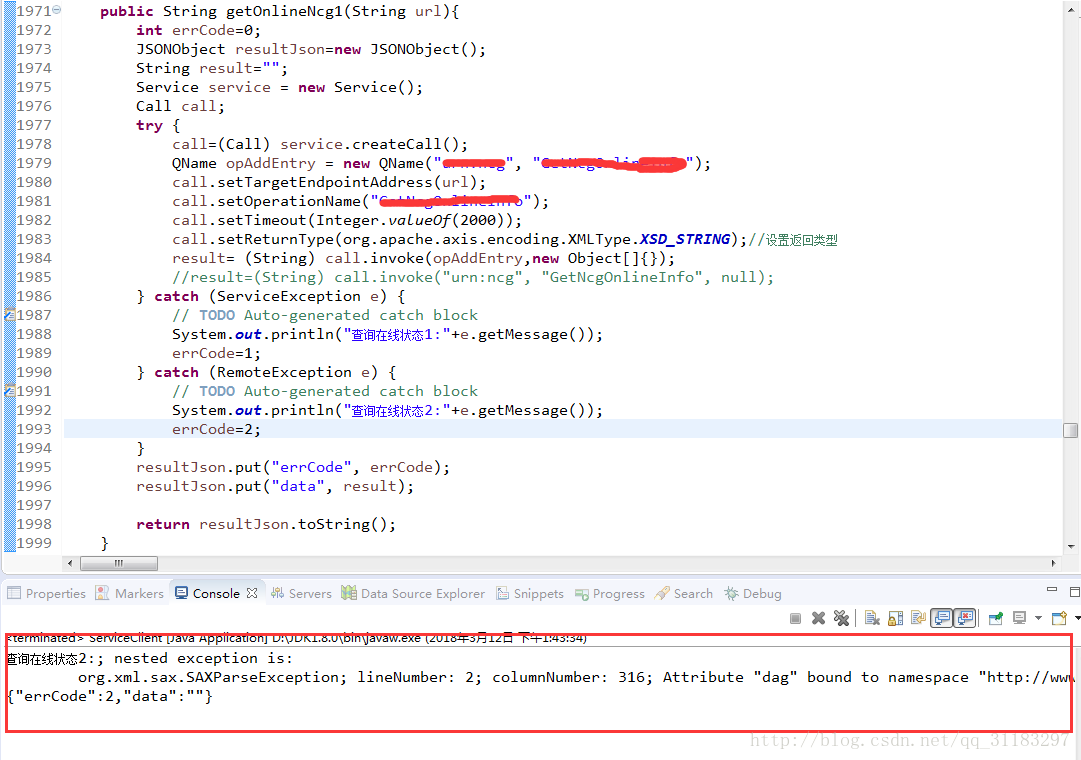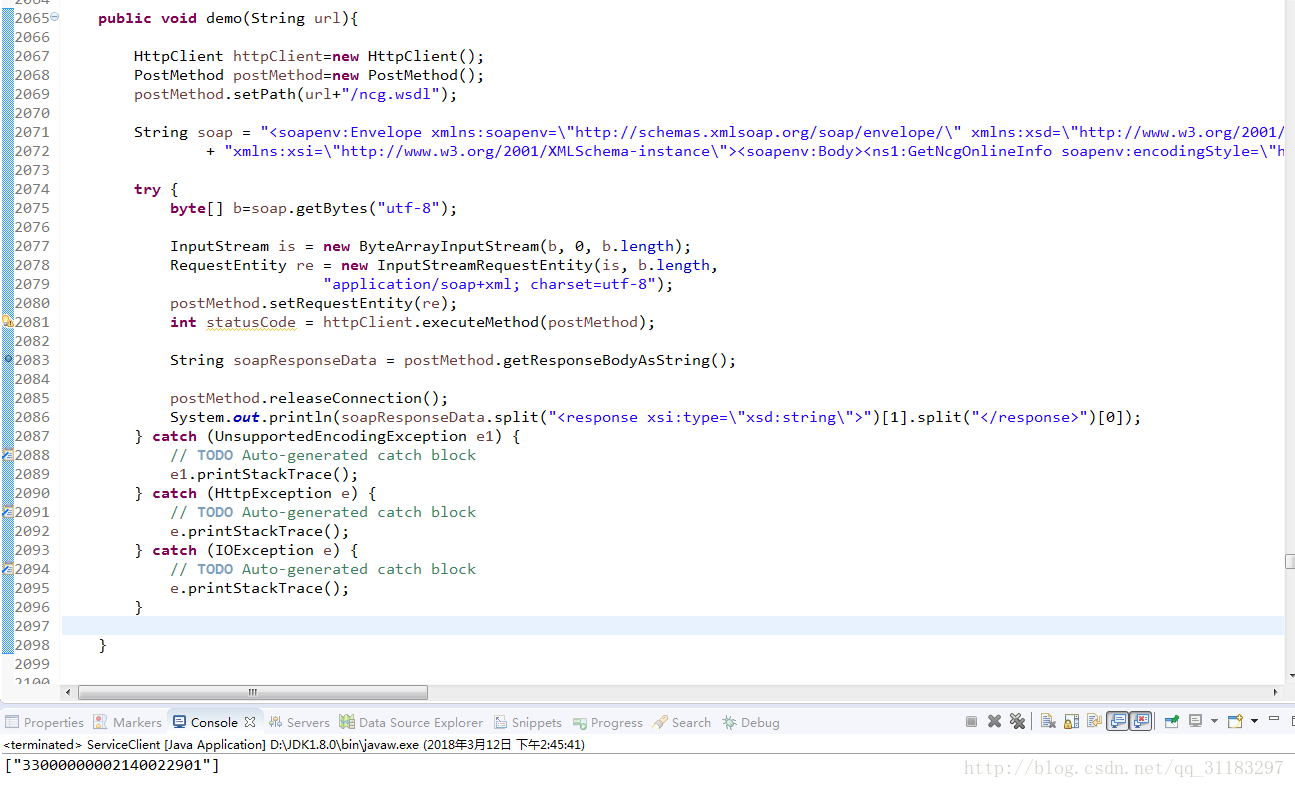java调用WebService服务的四种方法总结
作者:互联网
转自:https://www.jb51.net/article/230317.htm
WebService是一种跨编程语言、跨操作系统平台的远程调用技术,已存在很多年了,很多接口也都是通过WebService方式来发布的,下面这篇文章主要给大家介绍了关于java调用WebService服务的四种方法,需要的朋友可以参考下
目录
- 一、前言
- 二、简介
- 三、具体解析
- 第一种方式,首先得下载axis2的jar包,Axis2提供了一个wsdl2java.bat命令可以根据WSDL文件自动产生调用WebService的代码。
- 第二种RPC 方式,强烈推荐。
- 第三种:利用HttpURLConnection拼接和解析报文进行调用。
- 第四种,利用httpclient
- 总结
一、前言
本来不想写这个的,因为网上类似的是在是太多了。但是想想自己前面段时间用过,而且以后可能再也没机会用了。所以还是记录一下吧。我这儿是以C语言生成的WebService为例。因为通常来说,两个java端之间的互相通讯没必要写成WebService的方式,太麻烦。除非有一方已经固定了是webService的方式(常见于牛逼的甲方)。而且就算写成了WebService方式两个java端直接调用也相对比较简单,因为用java的话很多规范都是自动生成好的,而其他语言就不是这样了,有时候对方压根就不是正确的规范,你还不能让对方改!!!!!我觉得webService这个东西常用于不同语言编写的服务器之间进行数据交互。因为是基于WSDL的。我知道的主要的方法有以下几种(我这儿全部以C语言编写的WebService做优缺点比较):
二、简介
1、通过axis2将WebService提供的wsdl文件生成对应的java类,这样就可以相当调用本地类一样调用webService提供的接口。
优点:调用简单,无需自己编写太多的东西。
缺点:大部分情况根据对应的webService生成的服务中地址是固定的,不易更改,而且生成的代码过于庞大 ,不便于阅读。同时必须得有webservice对应的的wsdl文件,不太可控。
2、通过RPC方式调用(推荐使用)
优点:自己编写部分调用代码,可灵活更换调用的路径,适合分布式部署的服务器,只需要知道webservice服务的方法名、命名空间、以及对应的参数就好。
缺点:部分特殊情况下可能可以调用成功,但是无法获取返回值。稍后会进行说明。
3、通过HttpURLConnection进行调用,可用于补充第二种方法的不足之处。
优点:补充RPC方式的不足,代码编写量较少。
缺点:(C语言的WebService服务)大部分时候要自己编写输入的报文头,自己解析返回的报文。需要事先抓包查看报文。
4、通过httpclient调用。
和HttpURLConnection原理一样,只是用不同方法实现。优缺点也差不多。
三、具体解析
第一种方式,首先得下载axis2的jar包,Axis2提供了一个wsdl2java.bat命令可以根据WSDL文件自动产生调用WebService的代码。
wsdl2java.bat命令可以在<Axis2安装目录>/bin目录中找到。如果你配置了环境变量则可以在控制台中用一下方式
环境变量\bin\wsdl2java,具体如下。
%AXIS2_HOME%\bin\wsdl2java -uri d:demo.wsdl -p client -s -o stub
如果没有则自己键入到对应的位置执行。wsdl2java -uri d:demo.wsdl -p client -s -o stub
其中,-url是对应WebService的wsdl位置,可以是本地的也可以是网络的。-p是指定生成的类名。具体参数列表如下:
- -o <path> : 指定生成代码的输出路径
- -a : 生成异步模式的代码
- -s : 生成同步模式的代码
- -p <pkg> : 指定代码的package名称
- -l <languange> : 使用的语言(Java/C) 默认是java
- -t : 为代码生成测试用例
- -ss : 生成服务端代码 默认不生成
- -sd : 生成服务描述文件 services.xml,仅与-ss一同使用
- -d <databinding> : 指定databingding,例如,adb,xmlbean,jibx,jaxme and jaxbri
- -g : 生成服务端和客户端的代码
- -pn <port_name> : 当WSDL中有多个port时,指定其中一个port
- -sn <serv_name> : 选择WSDL中的一个service
- -u : 展开data-binding的类
- -r <path> : 为代码生成指定一个repository
- -ssi : 为服务端实现代码生成接口类
- -S : 为生成的源码指定存储路径
- -R : 为生成的resources指定存储路径
–noBuildXML : 输出中不生成build.xml文件
–noWSDL : 在resources目录中不生成WSDL文件
–noMessageReceiver : 不生成MessageReceiver类
生成完后可以在axis2的bin目录下找到对应的文件。文件和同类.java文件要大很多,并且调用路径是定死的(标红部分),改起来麻烦,反正我是不喜欢这种方式。虽然不要自己写,但是看着这么多行就不爽,太臃肿了。


调用方式如下。(方式应该有多种,没有去深入研究)
| 1 2 3 4 5 6 7 8 9 10 11 12 13 14 15 16 17 18 |
package client;
import javax.xml.namespace.QName;
import org.apache.axis2.addressing.EndpointReference;
import org.apache.axis2.client.Options;
import org.apache.axis2.rpc.client.RPCServiceClient;
public class TestAms {
public static void main(String[] args) throws Exception
{
AmsStub1 stub=new AmsStub1();
AmsStub1.SetAlarmServerCfgMsg setmsg= new AmsStub1.SetAlarmServerCfgMsg();
//ServiceStub.SetAlarmServerCfgMsgResponse re=new ServiceStub.SetAlarmServerCfgMsgResponse();
String str="{\"name\":\"demo\",\"id\":21,\"code\":\"161021021040288690\"}";//对应的参数
setmsg.setPAlarmCfgMsg(str); //设置参数
String re=stub.setAlarmServerCfgMsg(setmsg).getResponse(); //调用并获取返回值
System.out.println(re);
}
}
|
我工作中遇到的全是C语言编写的WebService,而且每个人编写的都有些区别,很多人给你的wsdl并不能直接成功生成对应的java类,而且这种方法还有上述的一些缺点,所以我抛弃了这种方法。(上述列的代码全是以前试验时用过的,那时候是成功的,写这个博客的时候我把所有能找到的wsdl全试着生成一遍,结果全部生成失败。心塞)。
第二种RPC 方式,强烈推荐。
这种方式不多说,直接看代码就懂了 。这是一个调用webService查询设备在线数的。
| 1 2 3 4 5 6 7 8 9 10 11 12 13 14 15 16 17 18 19 20 21 22 23 24 25 26 27 28 29 |
public String getOnline(String url){
int errCode=0;
JSONObject resultJson=new JSONObject();
String result="";
Service service = new Service();
Call call;
try {
call=(Call) service.createCall();
QName opAddEntry = new QName("urn:demo", "GetOnlineInfo"); //设置命名空间和需要调用的方法名
call.setTargetEndpointAddress(url); //设置请求路径
call.setOperationName("GetNcgOnlineInfo"); //调用的方法名
call.setTimeout(Integer.valueOf(2000)); //设置请求超时
call.setReturnType(org.apache.axis.encoding.XMLType.XSD_STRING);//设置返回类型
result= (String) call.invoke(opAddEntry,new Object[]{});
} catch (ServiceException e) {
// TODO Auto-generated catch block
System.out.println("查询在线状态1:"+e.getMessage());
errCode=1;
} catch (RemoteException e) {
// TODO Auto-generated catch block
System.out.println("查询在线状态2:"+e.getMessage());
errCode=2;
}
resultJson.put("errCode", errCode);
resultJson.put("data", result);
return resultJson.toString();
}
|
里面注释比较全。还有些别的设置也比较简单,自己琢磨就知道了。例如编码方式、解析时间等。
说说这种方式的问题吧。我在使用的时候遇到的是:和我对接的人编写了两个WebService。但是由于这两个中有许多部分是相同的,他就把这两个合并了,同时提供了两个命名空间(具体怎么操作的我也不清楚),那么问题了,这其中有一个命名空间的所有方法我都能成功调用,但是都无法收到返回值。当时我就方了,开始还是好好的,怎么就突然不行了,于是我继续执行,查看报错消息,同时抓包查看报文内容。终于给我发现了问题。
下图是返回结果报的错,大体意识就是说我设置的命名空间和对方的命名空间不匹配。然后RPC解析就失败了。

然后我利用Wireshark抓包,得到一下结果。可以看看出,我请求的是命名空间是 ns1="urn:ncg"(其余的都是wsdl默认自带的)。可是我收到的返回报文就变了。变成了这样的 xmlns:dag="http://tempuri.org/dag.xsd" xmlns:dag="urn:dag" xmlns:ncg="urn:ncg" 足足有三个啊。RPC按照默认设置的 ns1="urn:ncg" 去解析,那肯定什么都解析不了的。所以只有自己去解析了。这种情况可以利用第三种或者第四种方式进行调用。

第三种:利用HttpURLConnection拼接和解析报文进行调用。
还是上面那个查询设备的方法。只不过改了下。当然,我这是知道报文后的解决办法。
| 1 2 3 4 5 6 7 8 9 10 11 12 13 14 15 16 17 18 19 20 21 22 23 24 25 26 27 28 29 30 31 32 33 34 35 36 37 38 39 40 41 42 43 44 45 46 47 48 49 50 51 |
public String ncgConnection(String url,String method){
URL wsUrl;
int errCode=0;
JSONObject resultJson=new JSONObject();
String result="";
try {
wsUrl = new URL(url+"/"+method);
HttpURLConnection conn = (HttpURLConnection) wsUrl.openConnection();
conn.setDoInput(true);
conn.setDoOutput(true);
conn.setRequestMethod("POST");
conn.setRequestProperty("Content-Type", "text/xml;charset=UTF-8");
conn.setConnectTimeout(2000);
conn.setReadTimeout(2000);
OutputStream os = conn.getOutputStream();
//请求体
//<soapenv:Envelope xmlns:soapenv="http://schemas.xmlsoap.org/soap/envelope/" xmlns:xsd="http://www.w3.org/2001/XMLSchema" xmlns:xsi="http://www.w3.org/2001/XMLSchema-instance"><soapenv:Body><ns1:DeleteCascadeFromCms soapenv:encodingStyle="http://schemas.xmlsoap.org/soap/encoding/" xmlns:ns1="urn:ncg"><ncg-code-list xsi:type="xsd:string">["11241525"]</ncg-code-list></ns1:DeleteCascadeFromCms></soapenv:Body></soapenv:Envelope>
String soap = "<soapenv:Envelope xmlns:soapenv=\"http://schemas.xmlsoap.org/soap/envelope/\" xmlns:xsd=\"http://www.w3.org/2001/XMLSchema\" "
+ "xmlns:xsi=\"http://www.w3.org/2001/XMLSchema-instance\"><soapenv:Body><ns1:"+method+" soapenv:encodingStyle=\"http://schemas.xmlsoap.org/soap/encoding/\" xmlns:ns1=\"urn:ncg\"/></soapenv:Body></soapenv:Envelope>";
os.write(soap.getBytes());
InputStream is = conn.getInputStream();
byte[] b = new byte[1024];
int len = 0;
String s = "";
while((len = is.read(b)) != -1){
String ss = new String(b,0,len,"UTF-8");
s += ss;
}
result=s.split("<response xsi:type=\"xsd:string\">")[1].split("</response>")[0];
is.close();
os.close();
conn.disconnect();
} catch (MalformedURLException e) {
// TODO Auto-generated catch block
System.out.println("通讯模块1:"+e.getMessage());
errCode=1;
} catch (IOException e) {
// TODO Auto-generated catch block
System.out.println("通讯模块2:"+e.getMessage());
errCode=2;
}
resultJson.put("errCode", errCode);
resultJson.put("data", result);
return resultJson.toString();
}
|
正常来说,利用HttpURLConnection实现很多的调用不需要自己拼接请求头和解析返回结果的(例如java端提供的一些action或者controller),可是在这儿调用WebService,确确实实的需要自己手写。对比上面那个Wireshark抓包的结果可以发现,在请求体部分按照对方提供的wsdl进行拼接,结果部分也进行相同的解析。可以正确获得结果。

第四种,利用httpclient
简单来说,httpClient可以算是加强版的HttpURLConnection,httpClient的API比较多,也比较稳定,不容易扩展。HttpURLConnection比较轻量级,容易根据自己的需求进行扩展。但是稳定性不如httpClient。
这种方法具体实现思路和HttpURLConnection一样。只是有点小区别。代码如下:
| 1 2 3 4 5 6 7 8 9 10 11 12 13 14 15 16 17 18 19 20 21 22 23 24 25 26 27 28 29 30 31 32 33 34 35 |
public void demo(String url){
HttpClient httpClient=new HttpClient();
PostMethod postMethod=new PostMethod();
postMethod.setPath(url+"/ncg.wsdl"); //路径和wsdl名
String soap = "<soapenv:Envelope xmlns:soapenv=\"http://schemas.xmlsoap.org/soap/envelope/\" xmlns:xsd=\"http://www.w3.org/2001/XMLSchema\" "
+ "xmlns:xsi=\"http://www.w3.org/2001/XMLSchema-instance\"><soapenv:Body><ns1:GetNcgOnlineInfo soapenv:encodingStyle=\"http://schemas.xmlsoap.org/soap/encoding/\" xmlns:ns1=\"urn:ncg\"/></soapenv:Body></soapenv:Envelope>";
try {
byte[] b=soap.getBytes("utf-8");
InputStream is = new ByteArrayInputStream(b, 0, b.length);
RequestEntity re = new InputStreamRequestEntity(is, b.length,
"application/soap+xml; charset=utf-8");
postMethod.setRequestEntity(re);
int statusCode = httpClient.executeMethod(postMethod);
String soapResponseData = postMethod.getResponseBodyAsString();
postMethod.releaseConnection();
//解析
System.out.println(soapResponseData.split("<response xsi:type=\"xsd:string\">")[1].split("</response>")[0]);
} catch (UnsupportedEncodingException e1) {
// TODO Auto-generated catch block
e1.printStackTrace();
} catch (HttpException e) {
// TODO Auto-generated catch block
e.printStackTrace();
} catch (IOException e) {
// TODO Auto-generated catch block
e.printStackTrace();
}
}
|
结果:我这儿没有做更多的判断,直接输出,这种方式我以前其实并没有用到。如果有需要可以更具返回的状态判断是否成功。如果你去抓包的话,你会发现这个会和上面HttpURLConnection抓的一样。

总结:调用webService很多程度上需要依赖对方编写WebService是否严谨,如果足够严谨,推荐使用RPC方式编写,其余的更具实际情况进行选择
转自:https://www.jb51.net/article/230317.htm
标签:调用,java,WebService,生成,catch,new,String 来源: https://www.cnblogs.com/furenjian/p/16145823.html